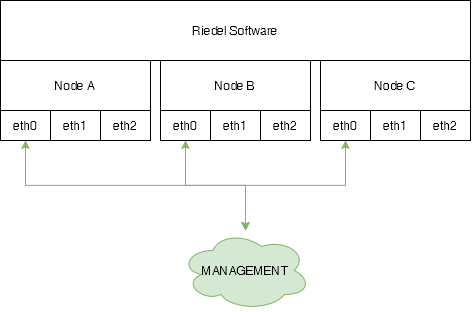Network Setup in High-Availability Scenarios
High-availability means the simultaneous use of a group consisting of at least three servers that work reliably with a minimum of downtime. In high-availability scenarios, some Riedel software services – such as STAGE – can be active on various Nodes of the high-availability Cluster in a distributed fashion. Since the allocation of services (several software modules with individual responsibilities running on one of the Cluster Nodes) to individual Cluster Nodes can change, all Cluster Nodes must provide the same network connectivity. Each network interface must be the same across all Nodes of the Cluster.
FQDN
The Fully Qualified Domain Name is a unique identifier for a resource in the network. A resource can be a device, but also be a service. In the end, an FQDN always maps a Name to an IP address.
A FQDN consists of labels divided by dots. The total number of labels is unrestricted, but the total length is restricted to 255 bytes. Example: stage-node1.myfacility.local
The resolution of a FQDN to an IP address is done by DNS.
Floating IP
Some Riedel Software – such as STAGE – provides a floating IP address. This IP address will reside on one of the Clusters Nodes and automatically fail over to another Node if this Node becomes unhealthy. This way, a single IP address acts as a single entry point for both web browsers and other external systems, allowing them to access all APIs of the Riedel software.
The Floating IP will be applied to the network interface which has its default gateway set.
The floating IP is provided through the Virtual Router Redundancy Protocol (VRRP) which implies the following requirements on the network side:
Local Multicast must be enabled.
The Riedel software will require a unique VRRP Router ID.


